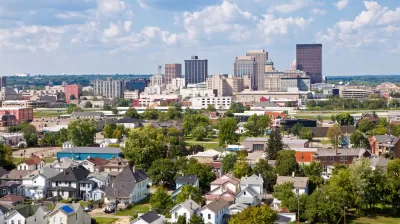Cities like Dayton expect to see a reduction in income tax revenue as more remote workers begin paying taxes to their home jurisdictions.

Officials in Dayton, Ohio and nearby cities remain concerned about a potential loss of income tax revenue from remote workers, even though projections that work-from-home could cost the city up to $20 million in revenue have not materialized this year. In fact, as Cornelius Frolik writes in the Dayton Daily News, “Dayton’s income tax collections were up 7.5% through the third quarter of this year, compared to the same period in 2021, according to city budget documents.”
Dayton workers who live in other jurisdictions are eligible for tax refunds, while employers are required to track remote work and withhold taxes accordingly. “Many employers have never needed to track where their employees live for tax purposes, and it can take time to figure out a good system to do that,” Frolik points out.
“The city believed the work-from-home impact would be more significant and would occur more swiftly, but it is taking time for businesses to create processes and procedures to track and account for remote employees, said Joe Parlette, Dayton’s deputy city manager.” As employers settle on new remote work patterns and set up new processes, Ohio cities are still bracing for potential revenue losses of 3 to 5 percent.
FULL STORY: Area cities losing millions to work-from-home shift, fear the worst is yet to come

Trump Administration Could Effectively End Housing Voucher Program
Federal officials are eyeing major cuts to the Section 8 program that helps millions of low-income households pay rent.

Planetizen Federal Action Tracker
A weekly monitor of how Trump’s orders and actions are impacting planners and planning in America.

Ken Jennings Launches Transit Web Series
The Jeopardy champ wants you to ride public transit.

Rebuilding Smarter: How LA County Is Guiding Fire-Ravaged Communities Toward Resilience
Los Angeles County is leading a coordinated effort to help fire-impacted communities rebuild with resilience by providing recovery resources, promoting fire-wise design, and aligning reconstruction with broader sustainability and climate goals.

When Borders Blur: Regional Collaboration in Action
As regional challenges outgrow city boundaries, “When Borders Blur” explores how cross-jurisdictional collaboration can drive smarter, more resilient urban planning, sharing real-world lessons from thriving partnerships across North America.

Philadelphia Is Expanding its Network of Roundabouts
Roundabouts are widely shown to decrease traffic speed, reduce congestion, and improve efficiency.
Urban Design for Planners 1: Software Tools
This six-course series explores essential urban design concepts using open source software and equips planners with the tools they need to participate fully in the urban design process.
Planning for Universal Design
Learn the tools for implementing Universal Design in planning regulations.
Ada County Highway District
Clanton & Associates, Inc.
Jessamine County Fiscal Court
Institute for Housing and Urban Development Studies (IHS)
City of Grandview
Harvard GSD Executive Education
Toledo-Lucas County Plan Commissions
Salt Lake City
NYU Wagner Graduate School of Public Service





























